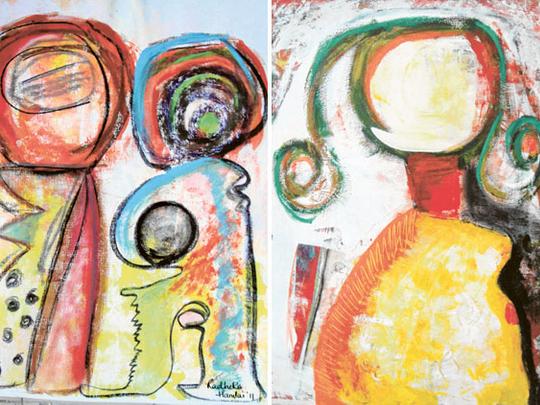
A well-known and acknowledged abstract artist in Oman, Radhika Hamlai's debut solo exhibition, Human Connections, recently opened at Shangri La Barr Al Jissa Resort and Spa's Art Gallery in Muscat.
Hamlai has participated in several group art exhibitions both in Oman and abroad and has been actively involved in organising exhibitions and workshops herself. But his exhibition marks a landmark moment in her artistic journey so far.
Originally from Ahmedabad, India, Hamlai has been painting since childhood; however, she only fully devoted herself to art after the birth of her first child in 2000, following which she began exhibiting her work.
"The art scene in Oman has grown considerably in the past six years or so," Hamlai says, referring to increased opportunities to exhibit and encountering collectors well versed in global art trends and intent on developing a solid relationship with the works they choose to collect.
Bold and incandescent patterns
Featuring 57 pieces in oils, charcoal, pen and acrylics, Human Connections can be considered to be a cumulative showcase of the dominant themes and techniques that Hamlai has been engaging in since her immersion into painting.
Inspired by an art teacher heavily rooted in spirituality and India's deep artistic heritage, Hamlai's initial works were a series of boldly patterned, incandescently hued responses to the intensity of the experiences during the spiritual pilgrimages she made in India. "The famous caves of Ajanta in Maharashtra especially captured my interest," she says, elaborating that her explorations of these intricately carved and painted caves laden with a palpable sense of history and spirituality would indelibly remain with her.
For Hamlai, inspiration is as much an immediate as an organic process. "It is all to do with the state of mind at that moment," she states, adding that the paintings nonetheless abstract and assimilate from the subliminal accumulation of observations, thoughts and memories in her mind over time — a visual commentary that the mind is continually conducting while interfacing with the world.
"A surface observation of even a minor detail can conjure up so many associative thoughts and connotations and that eventually spills over and becomes part of my work," she says.
Hamlai's work, including the more recent ones of brightly patterned and detailed humanoid figures, has been associated with densely and minutely textured and layered abstract art. Of her earlier work, Hamlai says that the figures populating her recent works were still present in her abstracts, although veiled, so to speak.
She interlinks it with her own artistic narrative as an emerging artist; the heavily textured surface was both a bid to conceal the figures and the artist's mode of engagement of putting a curtain between herself and the outside world.
Hamlai says that she has retained paintings from every stage of her journey as an artist, for it is essential for her to be able to witness the manner in which her work has gradually evolved.
In the past few years, the humanoid figures have erupted from the surface in a visible flurry of solid, unadulterated colour, pattern and form, and there is no greater testimony to their literal emergence than in Human Connections.
Bonds of kinship
The exhibition strives to depict the relationships between humans, whether it is a mother-child bonding or the relationship between a husband and wife, or even friends. Hamlai emphasises that the works are visual depictions of the spirit of companionship and bonding that constitutes the relationships themselves.
"Although most people view my work as abstract, I see it as a way of expressing my feelings. The human representations that animate my pieces tell the story of how we humans connect in different situations," she says.
Spirituality and the presence of a larger, unseen world peopled with spirits is important to Hamlai, evoking the Persian notion of the unseen world, or ghayb, from which the soul derives nourishment.
Hamlai thus seemingly strives to lend visibility to this mysterious and powerful invisible world through the medium of her paintings.
Furthermore, the paintings also become a personal means to record and preserve for posterity a memory especially dear to the artist. Prince and Princess, for instance, pays homage to the time when Hamlai's son and her sister-in-law's daughter would play-act as prince and princess every day after school.
"Of course, they have grown up now and no longer do so. Yet this painting documents that coordinate of time in which they suspended their realities and became fully immersed in their make-believe worlds," Hamlai says.
The notion of childhood and its inherent playfulness happens to be a theme both familiar and significant to Hamlai. "I feel that the child that you once were still lives within you, retaining that capacity of wonderment and curiosity," she remarks, saying that one may be compelled to assume layers of identities and responsibilities with the passage of time, and yet the inner child remains intact. Hamlai thus strongly identifies with and situates herself in a child's universe, imbuing her works with the child within.
Hamlai says she would like to continue to enlarge her present themes while charting new techniques. "Acknowledging and unleashing the child within and the strong element of spirituality will remain my signature themes and motivate my growth as an artist," she says.
Priyanka Sacheti is a writer based in Muscat.
Radhika Hamlai: Human Connections is on at the Art Gallery, Shangri La Barr Al Jissa Resort and Spa, in Muscat, until May 11.











